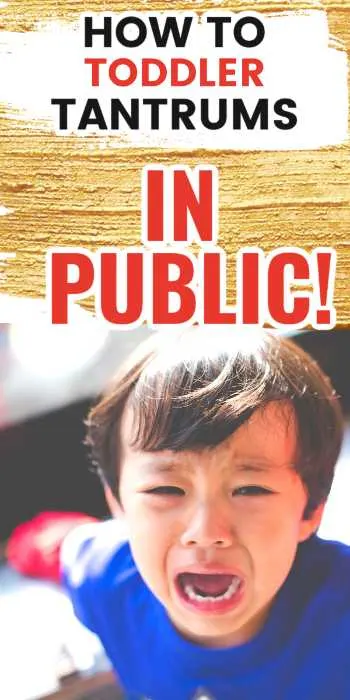Toddler tantrums can be embarrassing, frustrating, and downright draining.
Here are a few tips to help prevent them from happening in the first place, and how to deal with them when they do occur.
Toddler tantrums are a normal part of childhood, and less frequent than they used to be.
But how do you cope when this happens in public?
Some of the things that will be covered in this post include:
- What causes temper tantrums?
- How to Prevent Public Tantrums
- How to Handle Tantrums in Public
- How to Support Your Child During a Tantrums
- Free Toddler Tantrum Toolkit

(This post may contain affiliate links. To read our full disclosure policy click here.)
What Causes Toddler Tantrums?
Parents of toddlers know all too well the challenges that come with managing tantrums.
While tantrums can be frustrating and even exhausting, it’s important to remember that they are a normal part of child development.
There are a number of factors that can contribute to tantrums, including fatigue, hunger, and frustration.
Toddlers are still learning to communicate their needs, and they may become overwhelmed when they cannot express themselves clearly.
In addition, tantrums can be a way for toddlers to release built-up emotion or stress.
While it’s not always possible to prevent tantrums, there are some things that parents can do to help manage them.
How to Prevent Public Tantrums
No parent enjoys dealing with a tantrum toddler in public, but it’s, unfortunately, a situation that many of us find ourselves in from time to time.
While there’s no guaranteed way to prevent tantrums from happening altogether, there are a few things you can do to minimize the chances of a meltdown occurring when you’re out and about.
Plan Running Errands around Your Routines
First, try to stick to your child’s regular routine as much as possible.
If they’re used to having a snack at a certain time or taking a nap at a certain time, try to stick to that schedule as closely as you can while you’re out.
For us this usually means getting it out of the way as early on in the day as possible!
Making sure your child is rested and fed before heading out is one of the best ways we can prevent tantrums.

Have Your Child Participate
When we find ways to include children and let them participate in what we are doing…we can avoid so much frustration and teach new skills!
When you are at the grocery store you can have them participate by asking them to help you find certain items or even letting them walk with you instead of making them sit in the cart.
Be Prepared
Bring along some distractions for your child – whether it’s a favorite toy, book or game.
Having something to focus on will help them stay calm and avoid getting antsy.
Packing a snack and something to drink can be a good idea as well.

Grab your FREE Milestone Guide HERE.
Keep Outings and Errands Short
Although outings and errands can be fun, they can also be exhausting for small children.
Try to keep your outings short and sweet, and make sure to schedule plenty of downtime at home afterward.
Be Flexible…Tantrums Happen!
Finally, be prepared to leave the activity or location if necessary.
Sometimes the best thing you can do is calmly remove your child from the situation if they’re starting to get too worked up.
By following these tips, you can hopefully avoid public tantrums – but even if one does happen, don’t worry – we’ve all been there!
How to Handle Tantrums in Public
A child’s tantrum while grocery shopping or sitting in the dentist’s waiting room can cause a lot of parental stress!
People are looking at you and watching to see how you handle tantrums.
The big thing to keep in mind is that this tantrum…is nobody’s business but you and your child!
It does not mean that you are a bad parent if your child throws a public tantrum and if any other parents are judging you for it…well then clearly they don’t understand child development because tantrums are normal!
The best thing you can do is take a deep breath and move on with supporting your child during a temper tantrum.

How to Support your Child During a Tantrum
It can be difficult to remain calm when your child is throwing a tantrum, but it is important to try to do so.
When you remain calm, you model appropriate behavior for your child and help to de-escalate the situation.
It is also important to validate your child’s emotions. Let them know that it is okay to feel angry, frustrated, or upset.
Try to provide comfort and understanding.
Once the tantrum has passed, you can talk with your child about what might have caused the tantrum and help them to find more appropriate ways to express their emotions in the future.
Staying Calm During Temper Tantrums
When your child is having a tantrum, it can be difficult to remain calm.
However, it is important to try to stay calm and avoid escalating the situation.
One way to do this is to take a few deep breaths and focus on your child’s emotions.
Although it may be tempting to try to reason with your child or offer bribes, this will likely only make the situation worse.
Instead, try to validate your child’s emotions and let them know that it’s OK to feel angry or upset.
You can also offer physical comforts, such as a hug or a pat on the back.
By remaining calm and understanding, you can help your child through this challenging moment.
Toddler Tantrum Toolkit
This all sounds great…but it can be hard to remember in the moment!
That is why I created my one-page Toddler Tantrum Toolkit!
It is a FREE one-page handout with some quick reminders on how to best support your child when any temper tantrum occurs.
Toddler tantrums can be frustrating, but with a few tips, you can help prevent them from happening in the first place.
If they do occur, try to remain calm and understanding –validating your child’s emotions- and provide physical comfort.
By following these tips, you can hopefully have a more peaceful shopping experience or a trip to the dentist!
Frequently Asked Questions
It is generally not recommended to ignore toddler tantrums as this can often escalate the situation.
It is important to try to remain calm and provide comfort and understanding.
Once the tantrum has passed, you can talk with your child about what might have caused the tantrum and help them to find more appropriate ways to express their emotions
Hugs can be a great way to provide comfort during a tantrum.
Just make sure that your child is receptive to a hug and that you are not forcing them.
You know your child best and what will help to deescalate the situation.
Keep in mind that what works for one tantrum, may not work for another so you have to look at each individualized circumstance.
A tantrum is usually characterized by crying, yelling, and kicking.
It is often a way for your child to express their emotions when they are feeling overwhelmed or frustrated.
A meltdown, on the other hand, is often more severe and can be triggered by sensory overload.
Meltdowns can sometimes be mistaken for tantrums, but it is important to try to understand the difference so you can best support your child.
If you think your child may be having a meltdown, it is important to try to remain calm and provide a safe and comforting environment.
If you are concerned about your child’s tantrums, it is important to speak with your child’s doctor or reach out to early intervention.
They can help to rule out any underlying medical conditions and provide additional resources and support.
Related Posts You Will Enjoy
7 Signs Your Child is Not Ready for Potty Training
How to Get a Toddler to Listen without Yelling!
Gross Motor Activities for Toddlers that Burn Energy
How to Brush Your Toddler’s Teeth When They Refuse!
Need to find a babysitter you can trust? Try this!


Kayla O’Neill has a master’s degree in education as well as a bachelor’s degree in special education with an emphasis in early childhood education. She has been working as a developmental therapist with babies and toddlers in early intervention since 2012. She is also a mom with two young children.